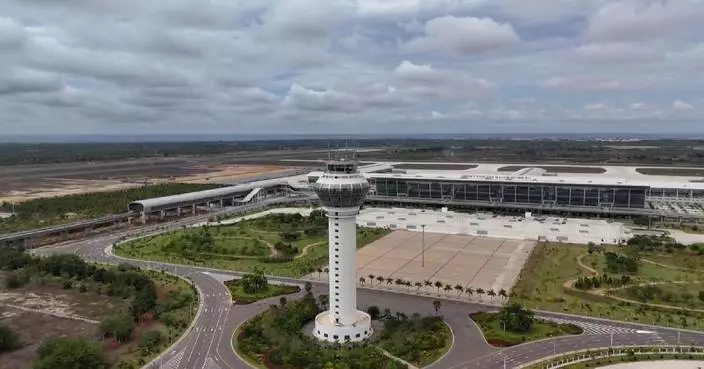The male Yangtze River finless porpoise completed his first month of life with well-developed body at the Institute of Hydrobiology (IHB), the Chinese Academy of Sciences in Wuhan, central China's Hubei Province.
On June 9, the female Yangtze River finless porpoise named "Fujiu" and raised at the Wuhan Baiji Porpoise Museum, gave birth to a male porpoise. The newborn porpoise was scheduled to meet the public in the afternoon of June 20. The Yangtze River finless porpoise, known for its mischievous smile and intelligence comparable to that of a gorilla, is a critically endangered species.
Over the past month, this little guy experienced ecdysis and developed his sonar system gradually.
"The baby Yangtze River finless porpoise could only dive underwater for over twenty seconds initially. Now, he can synchronize with his mom, with dive times reaching over one and a half minutes, indicating that his lung function is gradually developing," said Hao Yujiang, vice researcher at IHB.
To provide more nutrition for the baby, staff at the institute fed 6 kilograms of food to his mother Fujiu every day.
"The fat and protein content in finless porpois's milk is very high. We always choose fish with relatively high fat and increase the proportion of fresh bait appropriately," said Hao.
Three months after the birth of the baby porpoise, staff will adopt a mixed feeding method by adding small-sized fish to help him wean by the sixth month. During this period, the little porpoise will learn fishing and navigating obstacles with his mom. Between one and a half to two years old, he will separate from his mother and integrate into a new group.
"During this time, we need to take good care of him, managing his environment, community relations, and nutrition allocation. This helps us understand the reproductive patterns of this species and provides crucial data on breeding, management, and protection of wild Yangtze finless porpoises," Hao emphasized.

Baby Yangtze River finless porpoise thrives with well-developed body at one month old
The 2024 Los Angeles Auto Show, one of the largest car events in the United States, is in full swing, serving as a platform for major automakers to unveil their latest models and concept cars. This year's highlight is the industry's transition to electric vehicles (EVs).
Unveiling a new electric vehicle at the Los Angeles Auto Show is no longer a novelty. Manufacturers are now stepping up by introducing electric SUVs and trucks, reflecting the growing demand for versatile EV options.
"What we're understanding is that some of the biggest purchase decisions are made on range and charging. So, everybody wants to have a long-range battery. So, anything over 300 miles, it seems to be the sweet spot. That is when you start getting people to consider switching from a gas-powered car to an electric car," said Shad Balch, Director of Communications at Chevrolet.
Electric vehicles are the buzzword at this year's show, with automakers showcasing new models that promise better performance, longer ranges, and faster charging capabilities.
However, some experts have raised concerns about market saturation. In developed markets like California, many early adopters have already made the switch to EVs.
Despite the higher costs, government incentives continue to play a crucial role in making EVs more accessible.
"EVs are here to stay. They are the wave of the future. Electric vehicles are better for emissions. And the government is mandating that all manufacturers have to produce EVs," said Claudia Anderson, Product Specialist at Subaru.
California is leading the charge with a mandate requiring all new vehicles sold in the state to be zero-emission by 2035. This corresponds to the growing environmental consciousness among consumers, which experts believe is driving the increasing demand for EVs.
"I'm from California. And remember, growing up when we had "spare the air days" - that the air was too dirty to go play outside. So, California's made big strides in leading the way with environmental policy, and the vehicles are a nice complement to help achieve that solution," said Balch.
According to "Statista Market Insights," the U.S. EV market is projected to grow at an average annual rate of over 10 percent, with total unit sales expected to reach 2.3 million vehicles by 2029.

Los Angeles Auto Show 2024 highlights surge in EVs










